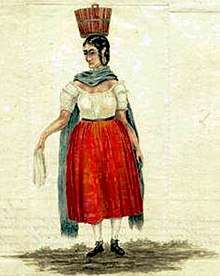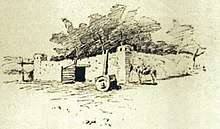Teresita Sandoval
Maria Teresa "Teresita" Sandoval Suazo (1811–1894) was among the first women of European heritage to live in the Arkansas Valley of present-day Colorado. She is one of the founders of El Pueblo in the current city of Pueblo, Colorado. She managed a ranch, the Doyle Settlement, in her later years.

Early life and relationships
Sandoval was born in 1811 at Taos, New Mexico to Gervasio Sandoval and Ramona Barela.[1][2] Around 1824[3] or 1828 Teresita Sandoval married José Manuel Suazo and they had four children, Juana "Juanita" María Suazo (1828-1916), María de la Cruz, José Thomas, and Rufina.[4][5] The family moved to Mora, New Mexico.[4]
Sandoval met Mathew Kinkead, a Kentucky native, about 1835. They had an affair, thus ending her marriage with Suaso. Sandoval and Kinkead had two children together named Juan Andrés (born November 29, 1835) and Rafaela.[5][6] Juan Andrés, also called Andrew, was born while Sandoval was still living with her husband. When it was known that the baby was the son of Kinkead, Sandoval moved out of the house and lived with Kinkead. Suaso died in 1844.[5]
In 1838, Kinkead owned three hundred sheep and a yoke of oxen, which he obtained from the sale of his house and land. The sheep grazed in pasture land along the Mora River. There was increased anti-American sentiment due to rumors that soldiers from the Republic of Texas were going to attack New Mexico. Kinkead began to fear both New Mexican people and Texans, who were described as a desperate band of men.[5]
Pueblo area settlements
—Historical marker, near El Pueblo History Museum
In 1841, Kinkead established a farm in Rock Canyon along the Arkansas River, six miles above the mouth of Fountain Creek, at future site of the Goodnight Rock Canon Ranch near the present-day Pueblo Reservoir. He had Dick Wooten trade his sheep for milk cows in Kansas City and deliver them to the farm, where he began to raise buffalo after taking calves from herds. Buffalo calves would suckle on cows and grew to be stronger than oxen. Wooten was probably his employee at the ranch, and Francisco Conn was likely his partner.[5] Sandoval and her daughters were among the first women of European descent in the Arkansas Valley. The others were Louisa Sandoval and Rumalda López Fisher.[7] Sandoval and Kinkead followed buffalo herds on the plains and captured newborn calves. They were in danger of attack from the buffalo and Native Americans. Sandoval was known for her courage.[8] Once they were about a year old, they were sold in Missouri for $100 each. He sold 44 buffalo in the spring of 1842.[5]

Sandoval and Kinkead were among the founders of El Pueblo trading post, the present Pueblo, Colorado.[2] Sandoval helped build and manage the fort.[4] She played an instrumental role in the daily operations of the post,[10] interacting with Native Americans, trappers, residents, businessmen, and famous American West characters. Goods traded at the fort included buffalo fur and leather, food, jewelry, and tools. The life included hard work and defense against Native Americans who defended their ancestral hunting grounds.[4]
She lived at the trading post with her children and parents.[11] Two of Sandoval's daughters were married at a young age. Juana was married before her 15th birthday to George Simpson by November 1842; Cruz married Joseph Doyle.[7] Both men were residents of El Pueblo.[12]
Alexander Barclay
Later, around 1843, Sandoval met Alexander Barclay, a British trader. In 1844, Sandoval, a 33-year-old grandmother, moved with Barkley to Hardscrabble,[13] where Barclay and Sandoval's son-in-laws built the settlement. Sandoval helped establish the settlement at Hardscrabble and Greenhorn.[3] At Hardscrabble, they operated a store, raised horses and cows, and grew crops. Native Americans and wolves depleted their stock, and they had difficulty with most of their crops.[14] Kinkead had moved to California with their son, Juan.[4]
Barclay reportedly moved to New Mexico to built a permanent house for Sandoval.[15] In 1848, Barclay and Doyle built Fort Barclay in northern New Mexico,[3] which he wanted to sell to the U.S. government.[15]
Prior to 1848, when the Mexican–American War ended, Mexican law allowed women to inherit and purchase land and livestock, to share ownership with their husbands, to establish their own businesses, and to begin divorce proceedings. After 1848, the new United States laws deprived women of these rights.[2]
Doyle Settlement
In 1853,[4][16] or after Barclay's death in 1855,[3] Sandoval lived in a one-room house on the ranch of her daughter, Maria De La Cruz "Cruzita" Suaso Doyle (b. 1831), and son-in-law, Joseph Doyle.[4][3] Doyle established a 1,200-acre ranch and settlement, called Doyle Settlement, along two miles of the Huerfano River in what is now Pueblo County. The land was from the Vigil and St. Vrain Land Grant. Doyle died unexpectedly in 1864 and left the ranch to his wife. Sandoval managed the ranch from 1864 to the 1890s. Doyle Settlement remained in the family for decades.[17][18] She died in 1894 and is buried at Plaza Cemetery, Pueblo, Colorado.[2]
Popular culture
- She is portrayed, along with other notable Hispanic people of Pueblo, Colorado, in a mural, Corazon del Pueblo, by David Garcia at the Hispanic Resource Center at the Robert Hoag Rawlings Public Library.[19]
References
- Vincent C. de Baca (1998). La Gente: Hispano History and Life in Colorado. Colorado Historical Society. p. 6.
- "Teresita Sandoval (1811-1894)". Women of the West Museum. Retrieved 6 October 2017.
- "Historical Characters". Spanish Peaks Country. Retrieved June 12, 2018.
- "Terisito Sandoval" (PDF). History Colorado. Retrieved June 12, 2018.
- Janet Lecompte (November 1, 1980). Pueblo, Hardscrabble, Greenhorn: Society on the High Plains, 1832-1856. University of Oklahoma Press. pp. 37–40. ISBN 978-0-8061-1723-2.
- Baca (1998), p. 9
- Lecompte (1980), p. 44.
- Lecompte (1980), pp. 67, 73.
- Lecompte (1980), p. 51.
- "El Pueblo". Colorado Encyclopedia. November 18, 2016. Retrieved June 11, 2018.
- Irene Isabel Blea (1995). Researching Chicano Communities: Social-historical, Physical, Psychological, and Spiritual Space. Greenwood Publishing Group. p. 45. ISBN 978-0-275-94974-7.
- Jolie Anderson Gallagher (April 2, 2013). Colorado Forts: Historic Outposts on the Wild Frontier. Arcadia Publishing Incorporated. p. PT49. ISBN 978-1-61423-903-1.
- Lecompte (1980), p. 125.
- "Groundbreaker: Alexander Barclay". The World Journal. October 15, 2015. Retrieved June 12, 2018.
- Gregory F. Michno (September 14, 2017). Depredation and Deceit: The Making of the Jicarilla and Ute Wars in New Mexico. University of Oklahoma Press. p. 219. ISBN 978-0-8061-5944-7.
- Lecompte (1980), pp. 233-234.
- "Doyle Settlement". Colorado Preservation Inc. Retrieved June 12, 2018.
- "The Doyle Settlement". Southern Colorado Territorial Daughters. Retrieved June 12, 2018.
- Perez, Gayle (March 24, 2012). "New mural reflects rich Hispanic, Latino history". Pueblo Chieftain. Retrieved June 12, 2018.
External links
- Teresita Sandoval at Find a Grave
- Teresita Sandoval, historical marker